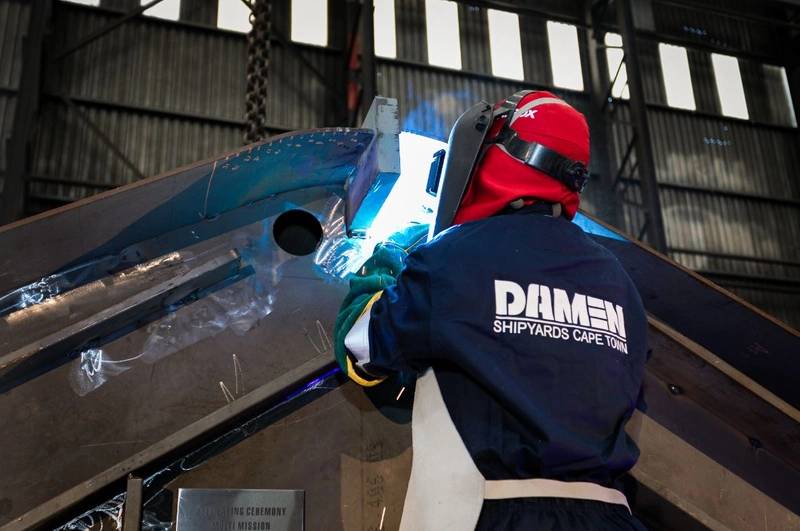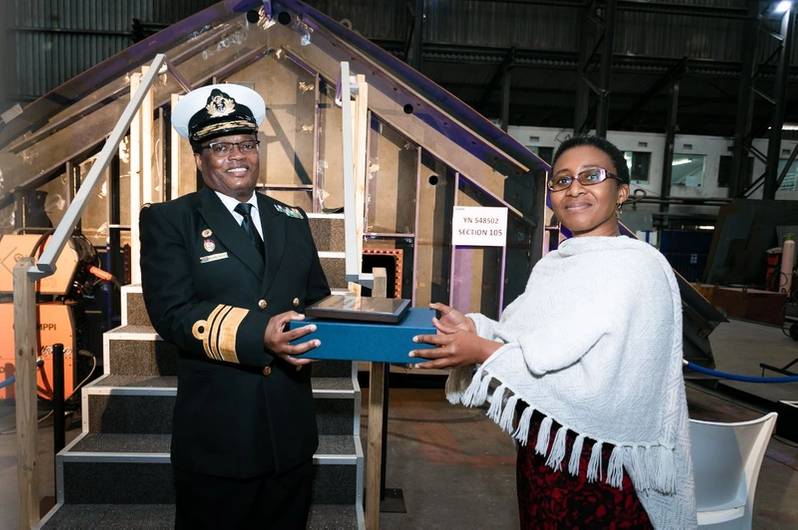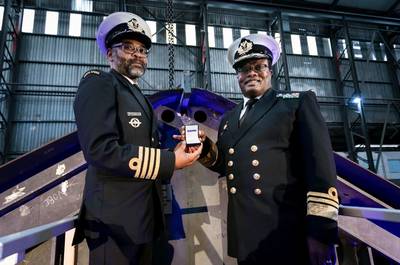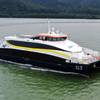Damen Lays Keel for South African Patrol Boat
On August 28, Damen Shipyards Cape Town (DSCT) held a keel-laying for the second of three Multi-Mission Inshore Patrol Vessels (MMIPV) that it is building for the South African Navy’s Project BIRO.
The South African Navy’s Project BIRO aims to develop maritime security, ensuring the country’s capabilities to respond effectively, rapidly, and cost-efficiently to maritime threats such as piracy and illegal fishing.
The MMIPVs draw on proven technology from Damen’s standardized range of patrol boats, which covers everything from 10-meter Interceptors and 50-meter patrol vessels, to 140-meter frigates. The vessels for Project BIRO are tailored to the specific requirements of the South African Navy and feature the Damen Sea Axe Bow – a vertical hull form that reduces slamming for safe, comfortable operations in rough seas. The MMIPVs are the first Sea Axe vessels to operate in South Africa. The first Project BIRO IPV is expected to be delivered in 2021.
Chief of the Navy, Vice Admiral Hlongwane, said the current coronavirus pandemic situation only serves to increase the importance of Project BIRO. “A well-managed maritime sector is key to the country’s economic recovery from the pandemic… Fighting COVID-19 poses new dilemmas for South Africa in addition to the existing challenges of policing one of the largest maritime zones in Africa. South Africa must also fulfill numerous international safety responsibilities… any reduction in South Africa’s supply chain efficiency could wreak economic havoc on the country and its neighbors.”
 (Photo: Damen)
(Photo: Damen)
The project undertaking serves as a demonstration of Damen Maritime Security Solutions in action. With this initiative, Damen not only delivers a ship, but rather a total maritime solution, encompassing every aspect of vessel operation throughout the lifecycle as well as the contribution to a sustainable maritime industry in the region in which it operates.
To that end, Damen has embraced, adopted and integrated the various applicable government programs, such as the Defense Industrial Participation (DIP), Department of Trade and Industry’s Local Content and Enterprise and Supplier Development (ESD) and Youth Employment Service (YES Initiative) into its project approach, and by doing so is looking to over-achieve on the requirements of these programs. For example, Damen will exceed Project BIRO’s 60% local content requirements, issuing contracts to a large number of local suppliers. As a result of their work on Project BIRO, many of these suppliers are now earmarked for work on Damen projects in and outside of South Africa. Additionally, DSCT’s undertaking of the project has created more than 300 direct jobs and 1,000 indirect jobs in line with the South African Government’s Operation Phakisa objectives.
Damen’s Project Director for the MMIPV projects, Jos Govaarts, elaborates, “It’s not only our objective to build three IPVs. We, as DSCT, feel it is our responsibility to create jobs and to develop our suppliers. We have the commitment to make sure that the South African maritime industry fully benefits from South African projects for the long-term. The jobs that we are creating are there to stay.”
Following the speeches, the tradition of welding a coin to the keel was observed. On this occasion, the coin was welded into place by Jenny-Lee Fortuin (2nd Year Apprentice: Welder ), an apprentice of DSCT’s Apprentice Training Center, an institution established by the yard in order to bridge a skills gap in South Africa and provide employment opportunities to local learners. The minted coin being laid on this occasion was a commemorative medal that was made in the honor of the late President Nelson Mandela as the winner of the 1993 Nobel Prize for Peace. The obverse of the coin was designed by British Artist Avril Vaughan and the reverse was designed by artist Danuta Haremska.
 (Photo: Damen)
(Photo: Damen)













